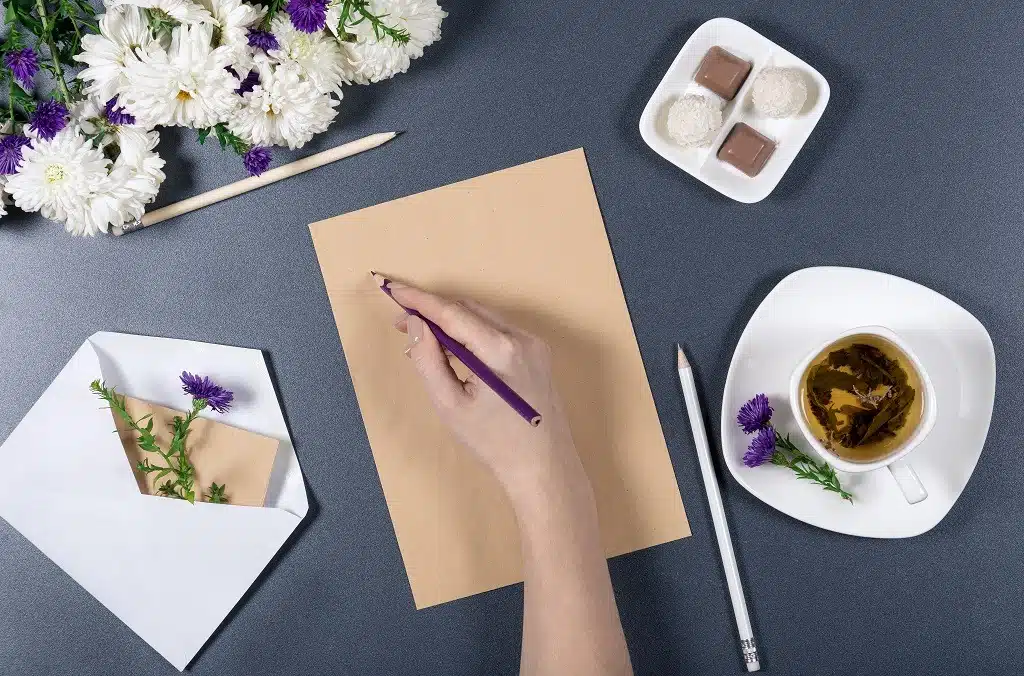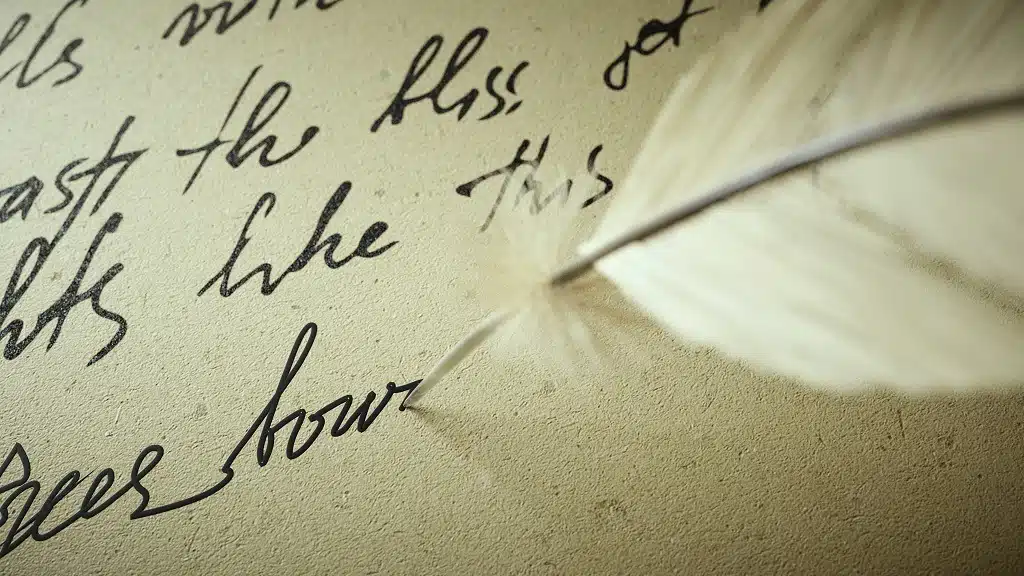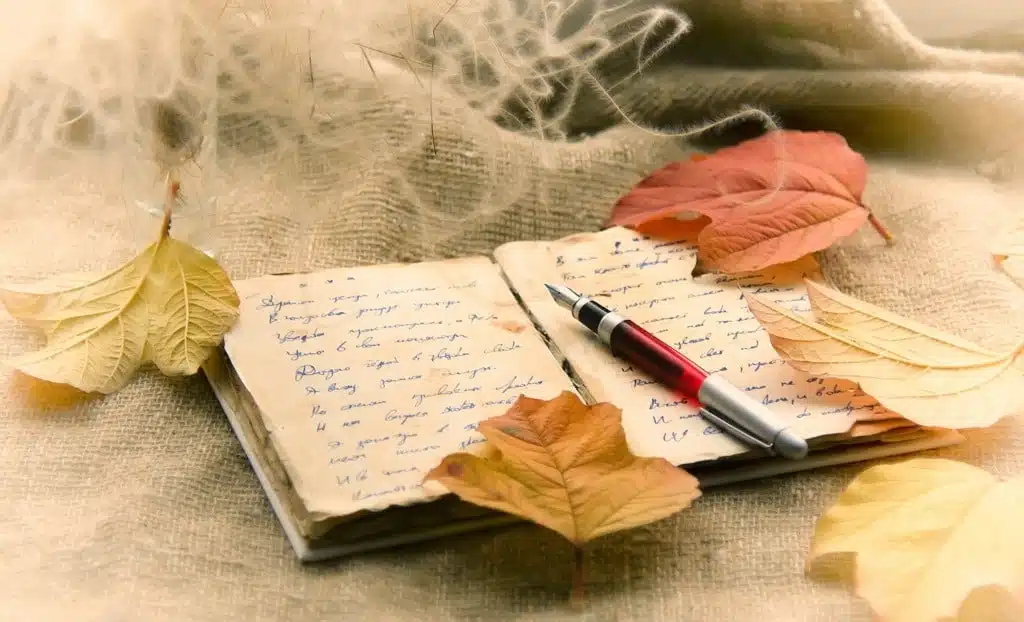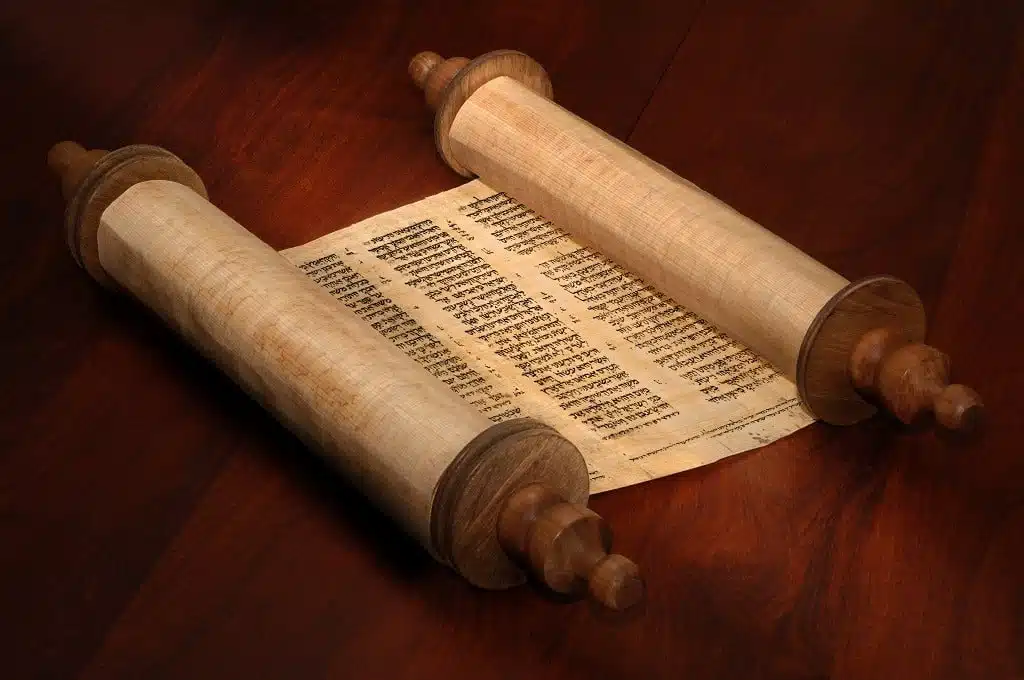Here’s what the Acrostic poetry form is:
Acrostic poems are a form of poetry that spell out a word or message in the first letter, word, or occasionally syllable of each line in the poem.
Some acrostics spell out the alphabet instead, but the core principle of using the beginning of the line to spell something out remains the same.
So if you want to learn all about the Acrostic poetry type, then you’ve come to the right place.
Keep reading!

Forms of Poetry: The Acrostic

Acrostics is a frequent poem in elementary and middle school classrooms since the concept is fairly easy for beginners to understand.
The word “acrostic” comes from the Greek akros and stichos, meaning “at the end” and “verse.”
Basic Properties of an Acrostic

| Rhyme Structure | Optional |
| Meter | Optional |
| Origin | Can be traced as far as Ancient Greece |
| Popularity | Can be traced as far as Ancient Greece |
| Theme | Can be anything, but acrostics about specific people are common (using a name for the acrostic element) |
How Are Acrostics Structured?

Due to the emphasis on the first letter or word of each line, it isn’t uncommon for acrostic poems to be divided firmly into sentences.
This can cause them to read like a list of statements and even poets who do combine acrostics with enjambment (sentences that continue across lines) are likely to choose lines that allow the first word to naturally stand out.
One thing to note about acrostics is that their length is predetermined by the word or message chosen by the poet.
This means that the writer has a finite and exact number of lines to get their point across, but the line of each individual line can vary.
Acrostics rarely employ rhyme or meter, since the writer is already under pressure without them, but this is more of a trend than a hard rule.
You could, in theory, do something ridiculous like writing an acrostic of the entire Declaration of Independence in rhymed Trochaic tetrameter if you wanted to.
I would call you a lunatic for even attempting it, but you could.
Another unique challenge that acrostics have to handle is that they have to announce themselves in some way.
When a reader picks up a sonnet or a haiku, not much meaning is lost if they’re unfamiliar with the form.

They may be missing out on some context or history that could enrich their understanding of the poem, but it will still make sense on the page.
Acrostics, on the other hand, often only make sense if you know what’s going on.
Rather than rely entirely on the reader for this, the writer usually makes formatting decisions that will make it clear.
The easiest and most obvious solution is to simply subtitle the poem “An Acrostic” and this is not an uncommon approach.
Acrostic poems will frequently use bold, italics, or some other formatting trick to make the first letter of each line stand out so that the reader pays closer attention to those letters.
The first letter will also almost always be capitalized, even if it appears in the middle of a sentence since it makes it easier to read the ‘hidden’ message on the page.
About the Abecedarius

An abecedarius, which is an acrostic that spells out the alphabet, can present a unique challenge since alphabets tend to be rather long compared to words.
Written in English, this poem would require a full 26 lines.
While this is a perfectly reasonable length for a typical poem, it should be remembered that the abecedarius also challenges the writer to use uncommon letters like “X” and “Z” at the beginning of lines.
It is not unheard of for an abecedarius to omit letters, but it could be argued that these efforts would not represent a ‘true’ abecedarius, though it would certainly still be an acrostic poem.
The Double Acrostic

As if the form wasn’t challenging enough already, some writers take it upon themselves to make it more extreme by writing a poem that utilizes both the first letter of each line and the last letter of each line.
They may be the same word/message or present two different words or messages.
Double acrostics are absolutely not recommended for beginners.
It’s hard enough making the poem sound natural and organic when the first letter of each line is restricted.
The more restrictions you place on your writing, the more difficult it will be to make it flow properly.
Of course, showing off that you are capable of rising to these challenges is part of the fun of the form.
Much of the admiration that writers of acrostics experience comes from the reader’s understanding that the seemingly natural flow of the words on the page had to accommodate the strict limitations of an acrostic.
Example of an Acrostic

An Acrostic by Edgar Allan Poe
Elizabeth it is in vain you say
“Love not” — thou sayest it in so sweet a way:
In vain those words from thee or L.E.L.
Zantippe’s talents had enforced so well:
Ah! if that language from thy heart arise,
Breath it less gently forth — and veil thine eyes.
Endymion, recollect, when Luna tried
To cure his love — was cured of all beside —
His folly — pride — and passion — for he died.
Edgar Allan Poe’s poem titled simply “An Acrostic” spells out the first name of the subject.
Interestingly, Poe also includes the name in the poem itself as the first word.
This is not typical of acrostics but is an excellent way to provide context in this example since we might not know who Elizabeth is otherwise.
Poe truly took no risks with the reader’s understanding, even going so far as to title the poem after the form, so that you immediately know what you’re getting into.

Take note that even though Poe utilizes enjambment and varies up the ends of each line, as is typical of his work, the individual lines do mostly contain complete thoughts.
This allows the first letter of each word to stand out naturally since it’s also the first letter of a new thought.
Poe’s poem is a good example of the right structure for a beginner.
It doesn’t use rhyme, meter, consistent line lengths, or any extra limitations other than being an acrostic.
This isn’t surprising, since Poe was not a writer who was well-known for acrostics.
This was most likely an experiment that he wrote at some point to entertain himself, as writers often do.
History of Acrostics

These poems have appeared throughout written history, appearing in the Hebrew Bible, popular works of the medieval era, and all the way up through to the present day.
Some of the earliest examples come from Ancient Greece.
This won’t surprise any fans of poetry and the arts, but it may surprise you to hear that their acrostics would be written out on leaves and then arranged in order.
Hebrew texts used the abecedarius form.
In this case, the alphabet spelled out would be the 22 letters of the Hebrew alphabet.
Medieval literature was truly when acrostic poems were in their prime.
In this era, it was already common to print the first letter of the text in a large decorative graphic in order to grab the reader’s attention, so acrostic poetry was a natural fit.
They were even sometimes used at the beginning of prose pieces as using acrostic poetry to spell out the writer’s name became popular for a time.
Tips for Writing an Acrostic

Always start out by determining what word or message your acrostic will convey.
Writing out an entire poem and then converting it to an acrostic later would be far more tedious.
Decide what it is you want to say about that particular word or message.
While many acrostics simply choose something arbitrary, like the alphabet or the writer’s name, a word or message that is chosen with purpose will usually inform the theme of the poem as a whole.
If your core word is ‘freedom’ for example, then you may want to think about what images and arguments best complement it as a concept.
Choosing a word or message and then writing a poem that has little or nothing to do with the acrostic itself will only raise questions, since you would be raising the difficulty of the poem without adding any artistic significance to it.
The most successful acrostics will feel like they flow naturally when spoken, so be sure to read it out loud both as you’re writing and when you’re finished to make sure it flows like speech.
Sticking to a strict rule (such as the first letter emphasis of the acrostic) without compromising on the speechlike quality of the writing displays mastery and is one of the most important goals a writer of acrostics should be aspiring toward.
For your first acrostic, choose a short word with common letters in it or use your own first or last name.
The advantage to using your name is that it’s likely to be much shorter than the alphabet in most cases but will still be something ‘arbitrary’ so that you can get some practice making the form itself work before you delve into the deeper levels of what makes an acrostic satisfying.
Of course, if your name includes an uncommon letter like “X” or “Z” somewhere in the middle, then it may present some difficulty anyway.
An uncommon letter at the beginning wouldn’t present as big of an issue.
As we saw with Poe’s acrostic, you could just start the poem with your name in that instance.
Poet’s Note

Acrostic poems are a great early poem form for young children since it lets them expand on that early life natural high of spelling out their own name.
Actually, when did that stop being fun?
Comprehensive Collection of Poetry Forms: Craft Words Into Art

Dare to traverse the entire spectrum of poetic forms, from the commonplace to the extraordinary?
Venture from the quintessential Sonnet to the elusive Mistress Bradstreet stanza, right through to the daunting complexity of Cro Cumaisc Etir Casbairdni Ocus Lethrannaigecht.
For those with a zeal to encounter the full breadth of poetry’s forms, this invitation is yours.
Start exploring the vast universe of poetic ingenuity with our comprehensive array of poetry forms right now!
